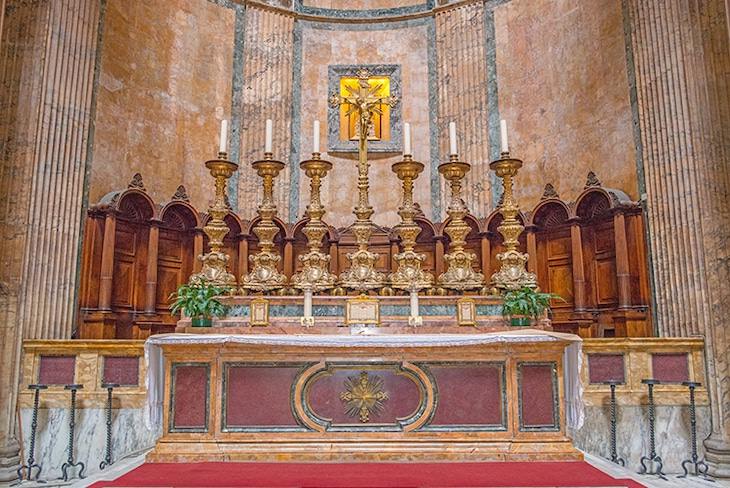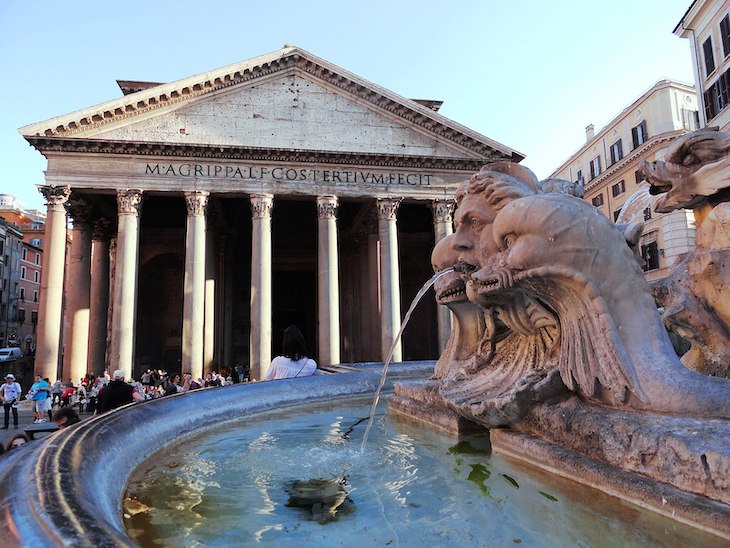
Wandering through the city of Rome, you are bound to see quite a few ancient buildings and modern churches. One of the city's most magnificent monuments - which happens to be both a church and an ancient landmark - is the Pantheon. Erected in Roman times as a political space, the iconic structure continues to fascinate engineers and visitors alike for its gravity-defying signature dome.
Apart from the impressive architecture, the Pantheon holds centuries of history, from Antiquity to the Dark Ages to Renaissance opulence. Here are 7 fascinating facts you probably don't know about this one-of-a-kind landmark.

For a long time, scholars were unsure about the exact origins of the Pantheon. It is now known that the iconic structure was dedicated at around 126 AD. The architect and the exact dates of construction still remain unclear. The building bears an inscription reading, “Marcus Agrippa the son of Lucius, three times consul, made this.” The text refers to the military leader Marcus Agrippa, who was the son-in-law of Emperor Augustus (who ruled from 27 BC to 14 AD). Agrippa was engaged in many building projects in Rome at the end of the Republican period.
Interestingly, the Pantheon building we can visit in Rome today isn’t the original one. The first Pantheon was destroyed in a fire in 80 AD, and a second building met its demise in a similar way in 110 AD. The present-day building dates to the reign of Emperor Hadrian. It isn’t clear why Hadrian put Agrippa’s original inscription on the new Pantheon, but this decision is what made it so confusing for scholars to track down the history of the building.
Some people may assume that the Pantheon is representative of Roman architecture, but the truth is that the building was unique at the time of its construction. The combination of a domed temple with a classic portico (columned porch) and traditional triangular pediment (the front piece of the portico) was relatively rare, especially for a building of such magnitude.

The dome, in particular, is considered a marvel of ancient engineering. It is the largest concrete dome in the world that is not reinforced by any supporting structure. According to David Moore, author of The Roman Pantheon: The Triumph of Concrete, no modern engineer would attempt such a feat.
Another remarkable feature of the Pantheon is the oculus, a roughly 20-foot wide opening in the ceiling of the dome. This hole serves an important architectural purpose by properly distributing the force of the large dome. It is also the only source of natural light in the interior of the Pantheon.
The architectural majesty of this monument inspired numerous builders through the centuries. Louis XV commissioned Jacques-Germain Soufflot to build the Pantheon in Paris, and Thomas Jefferson modeled his designs of the University of Virginia and the US Capitol Rotunda after the Pantheon.

In 1270, a central bell tower connecting the portico to the dome was added to the Pantheon. In the 17th century, Pope Urban VIII decided to remove this medieval addition and replace it with two new bell towers. However, his rendition wasn’t well-received. The bell towers were mocked by the public and referred to as ‘donkey ears,’ which didn’t compliment the classical facade.
While the two towers appear in some artist’s renderings from the period, many others preferred to leave them out and portray the Pantheon as they believed it looked like in ancient days. The bell towers were eventually removed by Pius IX in the 19th century.
Related: 15 Ancient Buildings You Can Enter Today

Image Source: Clayton Tang / Wikimedia Commons
The fact that the Pantheon withstood the persistent onslaught of time and nature for nearly 2,000 years is quite incredible. But what is the secret to the Pantheon’s (and other Roman monuments’) longevity? Many researchers presumed that there must be something special about the concrete used to build them.
A study published in 2014 confirmed that. It revealed that the key ingredient is the specific blend of limestone and volcanic ash used in the mortar. This combination caused “dense clusters of a durable mineral called strätlingite” to form in the mortar, which prevented the spread of microscopic cracks.

Left: The grave of Raphael and his fiancee Maria Bibbiena, Image Source: Ricardo André Frantz / Wikimedia Commons
The famed Renaissance artist Raphael probably needs no introduction. The Italian painter and architect had an extremely profound influence on the art world. Unfortunately, he passed away at the young age of 37 in 1520. As he was very highly regarded among ecclesiastical art patrons, Raphael was buried with great ceremony in the Pantheon.
And he is not the only Renaissance figure interred there. The Pantheon is also the final resting place of the artist Annibele Caracci, composer Angelo Corelli, and the Italian kings Vittorio Emanuele II and Umberto I.

Image Source: Bengt Nyman / Wikimedia Commons
The word Pantheon comes from Greek, and it refers to a temple dedicated to all the gods (pan- means "all," and -theon means "gods"). Despite the name, some scholars believe that the original purpose of the structure was not religious at all.
In 609 AD, the emperor Phocas gifted the Pantheon to Pope Boniface IV, who then blessed the building as the Church of Santa Maria ad Martyres. To this day, the Pantheon is an active Catholic church, where mass is celebrated on Saturdays, Sundays, and holidays. If you happen to be in Rome during the holiday season, Midnight Mass at the Pantheon is a sight not to be missed.
Related: These 9 Ancient Churches Are Almost As Old as Time

Image Source: MRFAVARD / Wikimedia Commons
The open square on which the Pantheon has long sat called Piazza Della Rotunda changed quite a few times over the years. In the 15th century, Pope Eugenius IV cleared the clustered medieval buildings in front of the Pantheon to create a paved plaza. A century later, the central stone fountain was added.
And in the early 18th century, an Egyptian obelisk was erected in the center of the redesigned fountain. But where did this interesting feature come from? The ancient red marble was brought to Rome in antiquity and rediscovered in the medieval period. All over Rome, ancient materials were often reused in early modern building projects.
Share these fascinating facts with friends and family